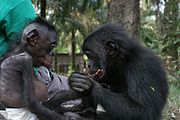
Lola ya Bonobo
Encyclopedia


Claudine André
Claudine André, , is a Belgian conservationist. She founded Lola ya bonobo in 1994, which is a bonobo sanctuary, just south of Kinshasa, at Mont Ngafula, in the Lukaya Valley, Democratic Republic of Congo.The aim of the sanctuary is to collect young bonobos, most having been orphaned due to the...
in 1994, Lola ya Bonobo is the world's only sanctuary for orphaned bonobo
Bonobo
The bonobo , Pan paniscus, previously called the pygmy chimpanzee and less often, the dwarf or gracile chimpanzee, is a great ape and one of the two species making up the genus Pan. The other species in genus Pan is Pan troglodytes, or the common chimpanzee...
s. Since 2002, the sanctuary has been located at the Petites Chutes de la Lukaya
Petites Chutes de la Lukaya
The Petites Chutes de la Lukaya is a set of small waterfalls on the Lukaya River. They are just south of Kinshasa, the capital city of the Democratic Republic of the Congo...
, just outside of Kinshasa
Kinshasa
Kinshasa is the capital and largest city of the Democratic Republic of the Congo. The city is located on the Congo River....
in the Democratic Republic of the Congo
Democratic Republic of the Congo
The Democratic Republic of the Congo is a state located in Central Africa. It is the second largest country in Africa by area and the eleventh largest in the world...
.
Lola ya Bonobo means 'paradise for bonobos' in Lingala, the main language of Kinshasa. In 2008, Lola ya Bonobo is home to 60 bonobos who live in 30 hectares of primary forest.
Typically, bonobos arrive as young infants. The bushmeat
Bushmeat
Bushmeat initially referred to the hunting of wild animals in West and Central Africa and is a calque from the French viande de brousse. Today the term is commonly used for meat of terrestrial wild animals, killed for subsistence or commercial purposes throughout the humid tropics of the Americas,...
trade in Congo sees hundreds of bonobos killed each year for meat and the infants are sold as pets. When confiscated, these infant bonobos are taken to Lola ya Bonobo. They begin life at the sanctuary with close care from a substitute human mother, but are usually quickly ready to be integrated into a peer group, and shortly afterwards into one of the large mixed-age social groups.
Although the bonobos are captive, they live in an environment similar to the wild. They can forage among dozens of edible plants and fruiting trees, compete for mating opportunities, and learn to avoid dangers such as stepping on venomous snakes just as they would in the wild. As a result, the bonobos at Lola ya Bonobo sanctuary, living in their forested microcosm, show all the naturally occurring behaviors observed in wild bonobos (in fact, they actually display some behaviors such as tool use that have not been observed in the wild).
Because of the living conditions provided, the sanctuary can play a critical role by demonstrating the level of humane treatment that captive apes deserve. The sanctuary also protects wild bonobos because it allows for the enforcement of domestic and international conservation laws aimed at preventing the trade in live bonobos. The sanctuary also acts as a mouth piece for conservation efforts in DRC by educating thousands of Congolese visitors each year about the value of Congo's natural history, in particular the bonobo – their unique Congolese inheritance.

